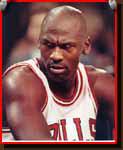Get A Grip!
How’s your grip on your emotional swings in trading? Are you able to narrow your focus when things start to go your way? Are you able to walk away (if even for a short time) when you recognize that you’re making mistakes? If a fly on the wall were to observe you during the day or during the week, what would he see when it comes to your self-control over your emotions?
Making and losing money (trading) inevitably stirs up some emotions within us. Whether it’s the pain and frustration of a losing trade stopping you out, the excitement of money flowing into your account by way of that trade you just nailed, or the uncertainty of that new position you just entered, trading can easily put logic on the backburner if you let it.
Few people are able to channel their raw emotions into their best state of performance. Michael Jordan and Tiger Woods come to mind. We’ve probably all seen them get a little miffed at a competitor or themselves, put on their game face, and just get hot instantly. However, the majority of people don’t have that ability, so removing as much emotion as possible is the best bet when it comes to damage control and staying cool under pressure.
Keep tabs on your emotions and take note of the times they help you and when they hurt you. If you find yourself digging a deeper hole when you get frustrated, then employ some logical steps to avoid repeating this mistake. If on the other hand you find your good days getting great as a result of your narrowed focus, then maybe you’ve got that special edge so many traders lack!
Jeff White
President, The Stock Bandit, Inc.
www.TheStockBandit.com
[tags]Trading Psychology[/tags]
Related Articles:








wavetrader | Jul 3, 2006 | Reply
You’re exactly right Jeff. Getting emotional about a stock is dangerous at best, psychotic at worst. Even when performing your technical analysis, people are often predisposed to see what they want to see rather than what the market is telling them.
What I do is look for patterns and play the pattern. I look at technicals to confirm the pattern I’ve spotted. I never get in to early, I wait for the pattern to reveal itself. The methodology one uses is important as well. It must be applied consistently and directly. Your trade should be a well thought out plan, with an entry, and exit and a profit target. I personally use a combination of Swing Trading, as described by Landry, and the Elliot Wave theory. I pick the entry points at a spot that will give me the best chance for success, I don’t anticipate.
For example, in an advancing trend, using the Elliot Wave, there are three impulse waves and two corrective waves. Wave three is usually the best money maker because it typically has the longest leg. But I don’t enter wave three until it has been confirmed and fully retraced leg 2. Some might say this is foolish because I may be missing out on as much as 50% of the profit potential. But I find it more profitable over the long run because the chances of that third wave coming to fruition is far greater at that point than it is if I chose to enter it when it first came out of wave two.
If it declines to break, then I fall back on a stop just below the peak of wave one, therebye avaoiding a loss and chalking it up to a flat trade. If I miss, no big deal, I’ll just wait for the next pattern setup. The stock market aint going no where.
Administrator | Jul 3, 2006 | Reply
Wavetrader, sounds like you’re pretty systematic about your trading and I like that. I’m not an Elliot Wave watcher, but if it works for you and promotes a disciplined approach, then it’s a good one to stick with. I like anything that can help remove emotions and help a trader enter and exit positions without the fear and excitement that can so easily complicate matters! That’s why I set up every one of my newsletter trades with risk/reward profiles and I know my exit on them all before I get in. It helps me trade the right size and it’s easier to accept those losses when they come because I knew going into the trade where I’d be getting out!
Thanks for your comments Wavetrader,
Jeff